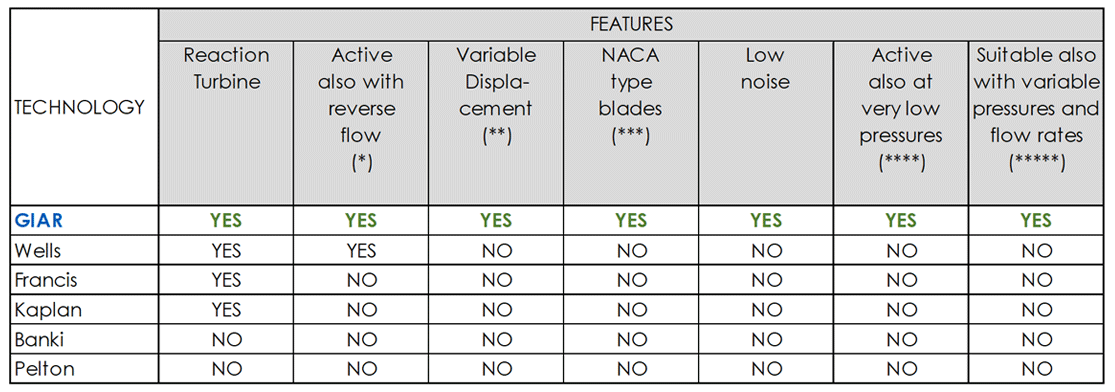Comparison with the different types of turbines used for the production of electrical energy
The turbines on the market show numerous critical issues, including low Efficiency, exclusive use in high- or low-power plants, high noise, reverse flow inactivity, complexity of construction and high maintenance costs.
The following synoptic comparative table shows the features of the main turbines currently in use in comparison with the features of the GIAR Turbine.
** The Variable Displacement feature ensures the optimization of the resonance parameters of OWC plants, increasing their overall Efficiency.
*** The NACA type blades make the GIAR Turbine a Reaction Turbine.
**** The GIAR Turbine can operate even in the presence of very low jumps.
***** In ensuring maximus Efficiency by optimizing the pressure and the speed of fluids, the Variable Displacement feature makes the GIAR Turbine the most suitable device for producing energy from fluids.
Below are described the main critical issues the most common turbines show, which are overcome by GIAR technology.
Wells Turbine
Main critical issues:
- It is not provided with the Variable Displacement feature, therefore it is not able to increase the overall Efficiency of OWC plants by optimizing the resonance parameters;
- It does not activate operating with low pressures (low jumps);
- It stalls (loss of power) operating with high pressures, that are typical in OWC plants;
- It is highly noisy;
- It has very low Efficiency.
Banki Turbine
Main critical issues:
- It is not provided with the Variable Displacement feature, therefore it is not able to increase the overall Efficiency of OWC plants by optimizing the resonance parameters;
- It is not a Reaction Turbine: the push on the blades is due to the centrifugal force exerted by the water flow forced to bend along the profile of the blades themselves, therefore there is no pressure difference in the water between the point of entry and the point of exit from the blades;
- It does not activate with low jumps, it is suitable for water jumps from 5 to 100 meters;
- Its use is limited to low-power plants;
- It is not a reversible flow turbine, therefore it is not suitable for OWC systems.
Kaplan turbine
Main critical issues:
- It is not provided with the Variable Displacement feature, therefore it is not able to increase the overall Efficiency of OWC plants by optimizing the resonance parameters;
- Its use is limited to jumps between 2 and 20 meters;
- It is not a reversible flow turbine, therefore it is not suitable for OWC systems.
Francis Turbine
Main critical issues:
- It is not provided with the Variable Displacement feature, therefore it is not able to increase the overall Efficiency of OWC plants by optimizing the resonance parameters;
- It activates with jumps starting from about 3 meters;
- It does not produce energy when the direction of the fluid flow is reversed. On the contrary, since it acts like a pump, when the direction of the fluid flow is reversed it absorbs energy.
Pelton Turbine
Main critical issues:
- It is not provided with the Variable Displacement feature, therefore it is not able to increase the overall Efficiency of OWC plants by optimizing the resonance parameters;
- It is suitable for high jumps and low flow rates;
- It is not a Reaction Turbine;
- It is not a reversible flow turbine, therefore it is not suitable for OWC systems.
GIAR Energy S.r.l. Benefit Company
Innovative Start-Up; Business Register Special Section REA N. MC-275955
Tax Code and VAT Number 02064820430; S.C. € 250.000,00 fully paid-up
Registered office: Borgo Conce n. 29, 62027 San Severino Marche (MC)
Operational Headquarters: Via E. Mattei n. 27, 62027 San Severino Marche (MC)
Representative Office: Via Pomezia n. 8, 63074 San Benedetto del Tronto (AP)

